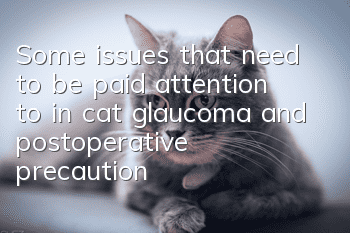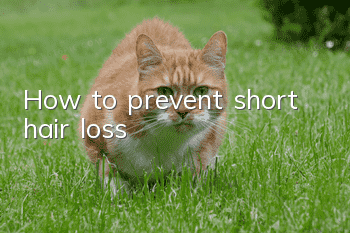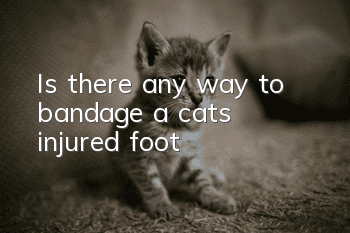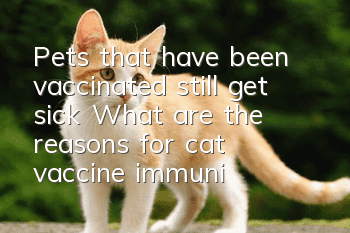Some issues that need to be paid attention to in cat glaucoma and postoperative precautions

The fluid in the eye, also called aqueous humor, is produced by the ciliary body behind the iris. This fluid passes through the pupil and then drains to the cornea and iris angle, where there is important tissue called the trabecular meshwork. The production and elimination of aqueous humor remain basically constant, resulting in relatively stable intraocular pressure. Normal intraocular pressure is 10-20mmHg.
Cat glaucoma is a disease caused by obstruction of aqueous humor drainage leading to increased intraocular pressure. High pressure on the retina and optic nerve can sometimes lead to blindness in cats. We will encounter many problems in the diagnosis and treatment of glaucoma in pet cats. Here are some answers to some noteworthy questions.
1. How do I know if my cat’s eyes are red due to glaucoma?
This question is related to whether the cat owner can take the cat to the hospital in time for glaucoma treatment. Because cats are not like us humans, when they have eye discomfort, they will go to the hospital or consult a doctor in time, and they can even search for relevant advice online. However, cats cannot speak, and owners sometimes do not know how to observe their pain. Therefore, many cases of glaucoma are already blind by the time they are taken to a specialist. Therefore, early detection and treatment are crucial to the vision of cats with glaucoma. Retention is particularly important.
Glaucoma is an ophthalmological emergency in cats. The initial symptoms of cats are mainly red eyes. Many cats will appear in poor spirits and may not be particularly active. However, a normal diet will not affect it. If the intraocular pressure is high, If it is high, corneal edema, which is the phenomenon of corneal whitening, may occur. However, these symptoms and many eye diseases may be difficult to distinguish based on appearance alone, so the most important thing is to take the cat hospital to a doctor in time for measurement first. Intraocular pressure, because this is the most important thing. Of course, not all increases in intraocular pressure are glaucoma. Many factors such as post-eye surgery, abnormal animal posture, abnormal blood pressure, etc. will cause an increase in intraocular pressure, but this does not necessarily mean glaucoma. Both are glaucoma, and this differential diagnosis requires a specialist to use professional eye examination equipment such as a gonioscope to make the distinction.
2. When a doctor evaluates an animal with glaucoma, what issues need to be considered most?
If you are treating a cat with glaucoma, the most important thing is to have a clear diagnosis before treatment. For professional cat ophthalmologists, we need to distinguish whether glaucoma is primary or secondary, because if it is primary glaucoma, most of the other eyes will have the same problem, and this risk needs to be considered in advance. and take action as early as possible. Primary glaucoma cannot be cured, but through proper management, vision can be preserved for as long as possible. Secondary glaucoma can be cured and vision restored as long as the primary disease is diagnosed clearly and treated promptly. Secondary blueOptophthalmia is often accompanied by many eye pathologies, such as hyphema, inflammation, tumors, and lens displacement.
Before treatment, the vision of the affected eye needs to be carefully evaluated, because this is the most important issue for all owners. Chronic glaucoma often causes vision loss and pain. Cats with vision loss caused by advanced glaucoma can still recover their vision as long as they are treated promptly, but if the treatment lasts too long, it will cause irreversible damage to the optic nerve. Therefore, glaucoma is an emergency in cat ophthalmology. When you find that your cat may have glaucoma, you should see a cat doctor for examination in time. Once glaucoma is diagnosed, see a professional cat ophthalmologist as soon as possible for long-term control.
3. What issues should we pay attention to after glaucoma surgery?
The first thing to note is that some cats’ owners will give them a lot of supplements after surgery. This is very incorrect for cats with glaucoma. In terms of food, we must be careful not to feed cats high-protein foods. If they often eat high-protein foods after surgery, it may cause scarring in the filtering channels in the cat’s body. This will easily lead to the surgery being in vain, so the patient You should pay attention to your post-operative diet, try to be as light as possible, drink plenty of water, and ordinary cat food will suffice.
The second issue that needs attention is to pay more attention when washing and bathing the cat, and move as slowly as possible to prevent water from flowing into the eyes. We also need to take medicine on time every day. In addition, we must wash our hands before instilling eye drops, and then we must prevent our hands and the medicine bottle from coming into contact with the eyes when instilling eye drops. If two potions are to be dropped, the time interval must be at least 5 minutes before using the other potion.
- How important is calcium and phosphorus to dogs and cats? The impact of calcium and phosphorus metabolism on cats’ bodies!
- What should novice cat owners pay attention to? What novice cat owners should pay attention to!
- Why did the mother cat suddenly kick and bite the kitten?
- How to get a cat to exercise
- How to solve the problem of neutered cats urinating indiscriminately
- How to feed and care for older cats?
- Regarding kittens, poop scavengers need to know these things
- What are the causes of dandruff in cats?
- Relapse rate after 411 suppression in cats
- What should I do if my Australian fog cat won’t sleep in the cat’s bed?



